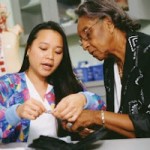ePrognosis. Assessing Life Expectancy of Older Patients.
ePrognosis. Assessing Life Expectancy of Older Patients.
What is ePrognosis?
Although many geriatric prognostic indices have been published, they may be difficult for busy clinicians to remember and use. Our goal is to be a repository of published geriatric prognostic indices where clinicians can go to obtain evidence-based information on patients’ prognosis.
To locate prognostic indices, we conducted a systematic review of the literature, published in JAMA January 11, 2011. Users should refer to this systematic review for detailed information on the accuracy, generalizability, potential for bias, and usability of these indices.
These indices are designed for older adults who do not have a dominant terminal illness. For patients with a dominant terminal illness, such as advanced dementia, cancer, or heart failure, prognostic indices specifically designed for those purposes should be used (see the Links tab).
The information on ePrognosis is intended as a rough guide to inform clinicians about possible mortality outcomes. It is not intended to be the only basis for making care decisions, nor is it intended to be a definitive means of prognostication. Clinicians should keep in mind that every patient is an individual, and that many factors beyond those used in these indices may influence a patient’s prognosis.
The sorting algorithm on the front page uses a balloon chart. We were inspired by the blog informationisbeautiful.
About the Authors
 Sei Lee, MD MAS
Sei Lee, MD MAS
Is an Assistant Professor in the Division of Geriatrics at UCSF. When not running after his 3 kids, he’s wondering why the same mountain biking trails are steeper now than 4 years ago.
 Alex Smith, MD MS MPH
Alex Smith, MD MS MPH
Is an Assistant Professor in the Division of Geriatrics at UCSF. Alex co-founded GeriPal, a geriatrics and palliative care blog, with Eric Widera. When not running after his 2 kids, he is trying to get his first serve percentage above 50%.
 Eric Widera, MD
Eric Widera, MD
Is an Assistant Professor in the Division of Geriatrics at UCSF. Eric co-founded GeriPal, a geriatrics and palliative care blog, with Alex Smith. When not running after his 1 kid, he is searching for the perfect scoop of ice cream.
 Lindsey Yourman, MD
Lindsey Yourman, MD
Is an intern at Scripps Mercy Hospital in San Diego. She was a 4th year medical student at UCSF and Research Fellow for the Division of Geriatrics at the time that she completed the study. She obtained her BA in Psychology from Harvard. Inspired by her grandparents and eprognosis mentors, she hopes to become a geriatrician.
 Mara Schonberg, MD MPH
Mara Schonberg, MD MPH
Is an Assistant Professor in the Division of General Medicine and Primary Care at Beth Israel Deaconess Medical Center. Mara is very lucky to have had 3 grandparents, in addition to her patients, teach her the importance of prognosticating when deciding on medical interventions.
 Cyrus Ahalt, MPP
Cyrus Ahalt, MPP
Is a Research Associate for the Division of Geriatrics at UCSF. There, he supports three principal investigators, each concerned with elder care and the importance of prognosis in determining care.
How to Use
To illustrate the clinical application of prognostic indices, we highlight 3 common clinical scenarios for older adults in which the consideration of prognosis may improve decision making:
| Case 1: Cancer screening | Case 2: Hospice eligibility | Case 3: Incidental pulmonary nodule |

Ms. A is a 78 year old clinic patient with well-controlled diabetes. She has no evidence of cognitive impairment and is independent in all of her activities of daily living. Should you recommend that Ms. A have breast cancer screening? |
 Ms. B is an 89 year old nursing home patient with congestive heart failure, end stage kidney disease, cognitive decline, and dependence on others for all activities of daily living. Should you discuss the possibility of hospice with her surrogate decision-maker? |
 Ms. C is an 85 year old with congestive heart failure, chronic kidney disease, and chronic malnutrition who is hospitalized for pneumonia. At the time of discharge she needs help from others to bathe and dress. She has never smoked. An incidental pulmonary nodule was found on admission chest x-ray and confirmed with a CT scan. Should you recommend serial follow-up imaging to her primary care doctor? |
Application of prognostic indices proceeds through the steps outlined below.
Step 1: Selecting the Best Prognostic Index (or Indices) for your Patient.
The most appropriate prognostic index for a given patient and clinical situation depends on 5 factors: prediction accuracy, model generalizability, usability, clinical efficacy, and time-frame.
Prediction accuracy refers to how closely the predicted risk of mortality matches the observed risk of mortality for individuals at different risk levels (calibration). Prediction accuracy also considers how well the model separates those at high risk of death from those at low risk of death (discrimination, usually reported quantitatively as a c-statistic). Generalizability refers to how well the index predicts mortality in various populations (e.g., the index was developed from a national sample; does it still work well in my patient population?). Practicality, or usability, refers to models with fewer, easy to enter data elements that are readily available during a clinical encounter. Clinical efficacy refers to testing the index in clinical settings, with a change in clinician behavior and beneficial effects on patient outcomes. None of the indices we examined tested clinical efficacy. Our sorting algorithm provides a potential framework for sorting these factors – see this explanation of how these factors are included in the algorithm.
Finally, clinicians should select indices that predict mortality over a time frame equal to that lag-time to benefit for the intervention. In some cases, no index that matches the time frame is available, but closer scrutiny of existing indices may reveal useful information. We found no index that predicts 6 month mortality for hospitalized elders. However, examination of the risk curve for the Walter 1-year index for hospitalized elders reveals that the highest risk group crosses the 50% predicted mortality mark at 6 months, and may therefore be useful for those seeking to assess hospice eligibility in hospitalized older adults.
Step 2: Estimating Mortality Risk Using a Prognostic Index.
After selecting a prognostic index (or indices) for his patient, the physician can estimate his patient’s mortality by answering a series of questions (i.e. filling in the relevant predictor variables) included in each index. The answers to each question are assigned points and the points are tallied to generate a risk score for each individual. The risk score is correlated with an absolute risk of mortality for a specified time period.
For example, using the Walter index to estimate Ms. C’s risk of dying within 1 year after being discharged from the hospital, one would answer that Ms. C is female (assigned 0 points), needs help with bathing and dressing (2 points), has congestive heart failure (2 points), does not have known cancer (0 points), has an admission creatinine >3.0 (2 points) and albumin <3.0 (2 points). The sum of the points equals a risk score of 8 (0+2+2+0+2+2 = 8), which on the table that Walter provides with her index, correlates with a 64% 1-year mortality for Ms. C. The calculations involved in estimating risk vary in complexity across the selected indices, from simple addition to complex mathematical formulas for others. This online compendium, ePrognosis, uses drop down menus to input predictor values and calculates mortality risk based on published formulas.
Step 3: Interpreting Mortality Risk from a Prognostic Index.
Often clinicians are interested in life expectancy estimates which exceed the time frame of most indices, and life expectancy must be inferred. For example, the Lee index for Ms. A predicts a 6-9% 4-year mortality risk. This means that out of 100 studied subjects with the same risk score as Ms. A, 6 to 9 of them would have died within 4 years. Because median life-expectancy for a group is defined as the point at which 50% of people die, clinicians can infer Ms. A.’s life-expectancy is likely greater than 4 years.
Clinicians must use clinical judgment to decide if the estimated mortality risk is accurate. Clinicians should consider possible sources of error, including limitations of the internal validity of the prognostic index, or error in the application of the index to the specific patient in front of them. Has the index been tested in settings that resemble the patient’s clinical situation? Is the index well calibrated at the predicted risk level – i.e. did observed risk closely match predicted risk in validation studies? Does the index have a good c-statistic, indicating that it accurately stratifies patients into low and high risk groups of mortality? The performance of the index in the original study is likely the ceiling for how well the index will perform in clinical settings. Does the patient have a protective factor (such as social support) that is not captured by the index?
Step 4: Integrating Prognosis into Clinical Care.
We now return to the cases to illustrate the use of prognostic indices in clinical practice:
| Case 1: Cancer screening | Case 2: Hospice eligibility | Case 3: Incidental pulmonary nodule |
|
|
Using an index that predicts 6-month mortality for nursing home patients, Ms. B has a 69% mortality risk at 6 months (Porock index), meaning a life-expectancy of less than 6 months. You counsel her son that Ms. B is eligible for hospice care in the nursing home. |
 Using an index for hospitalized patients, Ms. C has a 64% one-year mortality risk (Walter index). You suggest to Ms. C’s primary care doctor that follow-up imaging for her incidental pulmonary nodule may have limited benefit and even lead to harm from evaluation of false positive findings. |
How We Sort
We used the following criteria to sort the indices by accuracy, generalizability, bias, usability, and clinical efficacy. Please note that this framework was developed by the authors of ePrognosis. In this sense, it represents expert opinion. It has not undergone peer review and should be viewed as a preliminary starting point. You may weigh certain factors differently than us in sorting prognostic indices.
Excellent: Prospectively tested in a clinical setting demonstrating changes in clinician behavior with beneficial patient outcomes (a measure of clinical efficacy).
Very Good: Maintains accuracy when tested in a national sample or in heterogeneous populations.

- observed mortality range 50% or greater (a measure of usability)
- 10% points or fewer between the predicted mortality rate and the observed mortality rate (a measure of calibration)
- c-statistic of 0.7 or greater (a measure of discrimination)
- used data other than ICD-9 codes (a measure of potential bias)
Good: Accuracy suffers when tested in heterogeneous settings, or usability is limited.
- observed mortality range 30% or greater (a measure of usability)
- 15% points or fewer between the predicted mortality rate and the observed mortality rate (a measure of calibration)
- c-statistic of 0.65 or greater (a measure of discrimination)
- used data other than ICD-9 codes (a measure of potential bias)
- Use: number of times an index is selected (“clicked”) by users
- Usefulness: a user rating that the index was “useful” (responses can be submitted on the results page for each index). A “not useful” rating contributes negatively to the use/usefulness calculation.
- Usefulness is weighted more heavily than use.




















